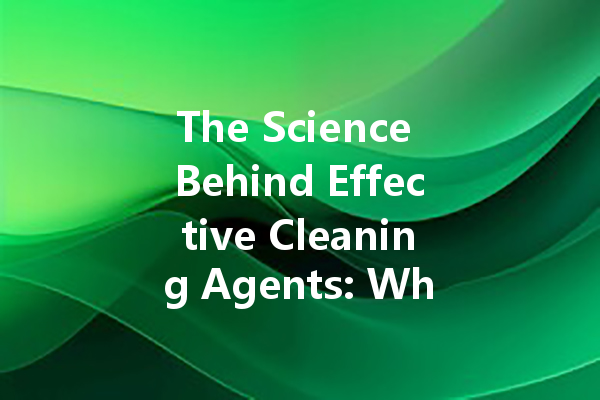Cleaning agents are essential components in maintaining hygiene and cleanliness in our homes, workplaces, and public spaces. Their effectiveness comes down to the science of how they work. This article explores the fundamental principles behind cleaning agents, the various types available, and the role they play in our daily lives.
Understanding Cleaning Agents
What Are Cleaning Agents?
Cleaning agents, commonly referred to as cleaners, are chemical substances designed to remove dirt, stains, and impurities from surfaces. They can be liquids, powders, or sprays, and they target various types of soils including grease, dust, and biological contaminants.
The Role of Chemistry in Cleaning
The effectiveness of cleaning agents hinges on their chemical composition. Cleaning agents interact with molecules in dirt and stains to break them down, allowing them to be rinsed away easily. Understanding the chemistry behind these interactions helps consumers pick the right product for their cleaning needs.
Types of Cleaning Agents
Surfactants
Surfactants, or surface-active agents, are one of the most common types of cleaning agents. They reduce the surface tension of water, allowing it to spread more easily over surfaces. This property helps in removing dirt and oil. Surfactants can be found in dish soaps, laundry detergents, and all-purpose cleaners.
Abrasives
Abrasives are cleaning agents that use physical scrubbing to remove dirt and stains. Commonly found in powders like baking soda and specialized scrubs, they work effectively on tough stains and are ideal for surfaces like ovens and sinks. However, they should be used cautiously on delicate surfaces to avoid scratching.
Solvents
Solvents are substances that dissolve other materials, making them particularly good at removing oily or greasy stains. Products like rubbing alcohol and nail polish remover are examples of solvents in action. They work by breaking down the chemical bonds in oils and greases, allowing for easier removal.
Enzymatic Cleaners
Enzymatic cleaners utilize biological enzymes to break down proteins, starches, and fats. These products are especially efficient for organic stains, such as food spills and pet stains. They are often favored in households with pets or children as they are generally safer and more environmentally friendly.
The Importance of pH Levels

Acidic vs. Alkaline Cleaners
The pH level of a cleaning agent determines its effectiveness in tackling different types of stains. Acidic cleaners, usually with a pH below 7, are excellent for dissolving mineral deposits like limescale and for cleaning metals. Conversely, alkaline cleaners, with a pH above 7, are more effective at breaking down organic matter such as grease and oils.
Choosing the Right pH
When selecting a cleaning agent, it’s crucial to consider the surface and type of dirt you are tackling. For instance, use acidic cleaners for bathroom tiles and alkaline solutions for kitchen surfaces. This understanding of pH helps optimize cleaning efficiency and safeguard the surfaces being cleaned.
The Role of Environmentally Friendly Cleaners
The Shift Towards Green Cleaning Products
There is a growing demand for environmentally friendly cleaning products as consumers become more eco-conscious. Green cleaners typically contain biodegradable ingredients that reduce harmful impacts on the environment. They often employ natural surfactants and solvents derived from plant materials.
Effectiveness of Green Cleaning Agents
While traditional cleaners are known for their potency, many green cleaning products are just as effective when used correctly. The formulation of these products often involves innovative approaches that enhance their cleaning power without relying on harsh chemicals. This allows for a cleaner home and a healthier planet.
Conclusion: Making Informed Choices
Understanding Product Labels
To choose the most effective cleaning agent, consumers should familiarize themselves with product labels and ingredients. Recognizing terms like “surfactant,” “solvent,” and “biodegradable” will help in selecting the right cleaner for specific tasks.
The Future of Cleaning Agents
As we continue to innovate in the field of cleaning agents, future products will likely prioritize safety, efficiency, and environmental sustainability. Understanding the science behind cleaning agents will not only enhance our cleaning routines but also promote a healthier living environment for everyone.
By becoming informed consumers, we can make better choices about the cleaning agents we use, ensuring a balance between cleanliness, health, and environmental stewardship.
